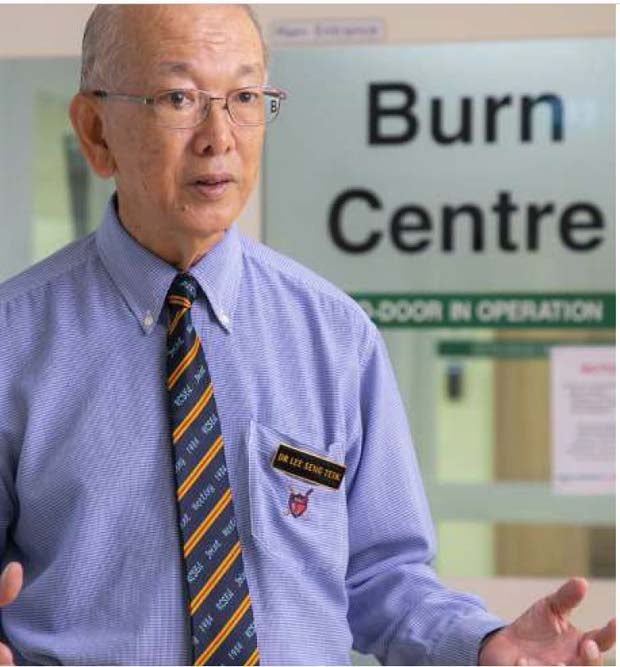
2021 is Prof Lee’s 46th year at SGH. He started at SGH in 1975 after he returned from his overseas studies and training, was interviewed by Mr Andrew Chew, Permanent Secretary of the Ministry of Health at Palmer Road where the ministry was based back then, and was promptly offered a job on the spot.
Professor Lee Seng Teik, Emeritus Consultant, SGH Plastic, Reconstructive & Aesthetic Surgery, is a walking compendium of SGH history and trivia. It is befitting that Prof Lee was also the founding director of the SGH Museum.
Prof Lee’s connection with SGH goes beyond the professional and the vocational. He recounts facts, recollections and observations about the institution and other associated bodies like the Academy of Medicine Singapore with relish, like someone who is talking about a beloved relative or friend.
His familiarity with the history of the institution is not only due to his having spent the bulk of his working life here. He states simply, more than once during the interview: ‘The history of this Campus is the history of Singapore. My interest in the Campus lies beyond Plastic Surgery; it extends to the buildings, education, research, infrastructure. We had nothing. What must be done? We will build ourselves. How it was done is similar to how Singapore has developed.’
Prof Lee was the founding director of SGH Museum when it first opened its doors in 2005. He wrote to Mr Howe Yoon Chong, Minister for Health from 1982 to 1985, to champion the conservation of the oldest buildings at SGH.
In 2005, President S R Nathan inaugurated the SGH Museum, which occupies part of Bowyer Block.
Later on, in 2009, the clock tower at Bowyer Block was also conserved. Both are now National Monuments.
‘This is not just institutional memory. It has to do with the whole national memory of Singapore,’ Prof Lee says emphatically. ‘If you ask the older generation, they all know the si cheng lao [clock tower in Hokkien]. How can you shift the footprint?’
He says that he is happy to see how the recent large-scale transformation of the Campus has been accompanied by a revamp of SGH Museum. The Hospital’s focus on being ready for the future hasn’t meant a dilution of its recognition of the past. The commemoration of SGH’s Bicentenary is significant to Prof Lee for this reason.
When he first joined SGH, the Burns Unit was a single-storey annexe at Norris Block with 40 beds. It was ‘a hut,’ he says, repeating this description a few times. But after the Spyros disaster, the government decided to revamp the Burns Unit at SGH. In October 1978, an explosion on board the Greek tanker,S T Spyros at Jurong Shipyard killed 76 and caused 69 persons to sustain severe injuries. Prof Lee says that when he first heard that his department was going to get two wards with 38 beds each for the new Burns Unit, he was filled with utter disbelief.
‘I had never heard of a 76-bedded Burns Unit before but, no, no, no, we will take the space,’ his voice brimming with pride now: ‘It is the only one in the world where there is a s kin culture facility. That means you can grow the skin in the lab within the unit.’
His time at SGH spans close to half a century. What remarkable years these have been! Prof Lee’s biography is a long list of his contributions, amongst them his involvement in stem cell research and his humanitarian trips to less privileged countries to perform cleft surgeries.
Yet he is eager to remind this writer at the very start of the interview, that long before the start of his career in 1975, there was an extraordinary group of people working at the Hospital: the first generation of locally-trained doctors and surgeons. ‘They were luminaries,’ Prof Lee says in a reverential tone. ‘President Sheares, Professor Monteiro…’ His voice trails off. ‘Today, the term for them would be heroes.’ Dr Benjamin Henry Sheares was Singapore’s second President and an eminent clinician in Obstetrics & Gynaecology. He was one of SGH’s pioneer Consultants, as was Professor Ernest Monteiro, the first Asian to hold the Chair of Clinical Medicine at the University of Malaya. Both men were respected as researchers and educators.
During Prof Lee’s headship at SGH Museum, he made sure that there were displays and a publication about the luminaries’ contributions.
The luminaries embody the qualities that continue to define SGH today: purpose, passion, courage and grit. Prof Lee is mindful of how this culture, like the historical buildings on campus, shouldn’t be taken for granted.
The refreshed SGH Museum was officially opened on 26 November 2021. Visit it today!
Excerpt is from Volume Two of SGH’s commemorative book “Sanctuary and Stronghold: SGH at 200”, authored by Dr Yeo Wei Wei.













 Get it on Google Play
Get it on Google Play